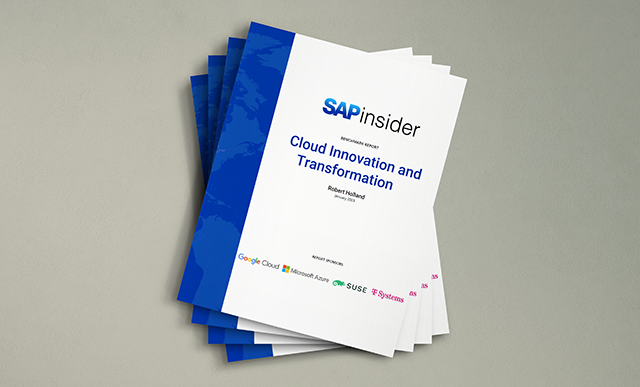Navigating the Digital Journey with SAP and the Cloud
For most organizations, the notion of digitizing your business has become a question of “when” rather than “if” — the age of digital business is here to stay. Many businesses are looking to SAP’s innovative solution portfolio to play a central role in helping them to achieve this goal, in particular SAP S/4HANA, SAP’s next-generation business suite built on SAP HANA that serves as a powerful digital core for your business.
Another key player in the digital transformation is the cloud, which provides access to a wide range of the innovations required for a digital business, from infrastructure solutions to sophisticated machine learning services. When it comes to mission-critical systems such as SAP applications, however, some organizations might hesitate to move to the cloud — businesses cannot afford to risk any productivity loss or application downtime. However, businesses also can’t afford to be left behind as others take advantage of the latest technologies to gain a competitive edge.
Here, we look at how a reliable and proven cloud infrastructure, such as Amazon Web Services (AWS), can offer a safe path toward a successful digital transformation.
A Foundation for Digital Transformation
As organizations build their business strategies around the digital economy, a key concern is having a proven, validated infrastructure in place that will support their needs. Organizations often already have specialized on-premise investments they want to leverage while also looking to new technology investments that will help take their business forward. Let’s look at a few of the key characteristics of a cloud infrastructure that are necessary for a strong digital foundation.
Alignment with SAP
For businesses with SAP landscapes, a cloud infrastructure that is aligned with SAP is critical — and not only aligned with current SAP technology, but also technology that is planned for the future. For instance, AWS has been working with SAP since 2008 to provide a complete slate of compute, storage, and networking services that support a variety of SAP solutions. A recent example of this collaboration is the Amazon Elastic Compute Cloud (Amazon EC2) X1 instance, which has been designed to meet the memory-intensive requirements of SAP HANA deployments. X1 instances are powered by four Intel Xeon E7 processors and provide up to 2TB of RAM per instance. They are fully certified by SAP for SAP HANA workloads, including very large scale-out deployments of up to 7 nodes or 14TB of RAM. AWS also continues to work closely with SAP to both develop and support upcoming technology advances.
Support for Integration
A cloud infrastructure that supports integration with your SAP environment can provide a clear, straightforward path for expanding your capabilities by lowering the barrier to new technology investments. For example, let’s say you’ve been considering an Internet of Things (IoT) or machine learning initiative and would like to leverage the data from your SAP environment as part of this deployment. A cloud infrastructure that integrates with SAP software, such as AWS, makes it easy to integrate these types of solutions with your existing SAP environment and accelerate your digital transformation. This integration support is a key component of a holistic cloud strategy that can bring you deeper insights, more agility, and new opportunities as a digital business.
Cost-Effective Scalability
With a cloud-based infrastructure, you can eliminate the overhead associated with purchasing and maintaining expensive, traditional hardware, which removes a significant consideration when it comes to building technology landscapes for the digital age. Instead of waiting to invest in the latest wave of innovation from SAP until you can make the case for the hardware investment, you can make the move and benefit from valuable functionality knowing that a cloud environment such as AWS has near infinite capacity and can scale at a moment’s notice to support changing needs. It is no longer a project where you must start buying pieces of hardware and adapting code — it is instead a service-oriented proposition where everything comes together on a singular platform.
Strong Security Measures
When it comes to the cloud, where data and applications move off premise, security is a particular concern — especially when it comes to complying with stringent regulations. For SAP customers, a cloud infrastructure must support a wide variety of international and industry-specific regulatory requirements and be able to meet the unique security needs of individual organizations. AWS, for example, is designed to help customers comply with a wide variety of regulatory requirements, including HIPAA, PCI, ISO, SOC, and more. Additionally, AWS provides assurance programs designed to help organizations maintain audit-readiness and compliance with regulatory requirements.
SAP Implementations in Action with AWS
AWS understands the requirements for a successful move to the cloud, which is why we provide tools and guidance to help businesses make this transition and ensure a successful digital transformation journey (see Figure 1). Many organizations around the globe are driving real business value by moving their SAP production landscapes to a cloud-based infrastructure run by AWS. Here are just a few examples of companies that are increasing their business agility and becoming more competitive in their respective fields by moving to the cloud.

Brooks Brothers
Founded in 1818, Brooks Brothers is a leading retailer of fashion wear and accessories in the US. To realize agility and cost savings, it decided to move its SAP HANA platform to the cloud, and leveraged AWS Quick Starts to help with the deployment. Moving to the cloud allowed Brooks Brothers to be nimbler in its approach in launching and testing new SAP software-based retail projects, reducing the time it typically took from weeks to hours.
Coca-Cola İçecek (CCI)
Another organization that achieved success by moving to the cloud is Coca-Cola İçecek (CCI), the fifth-largest bottler of Coca-Cola products. CCI leveraged SAP ERP Central Component (SAP ECC) for financial reporting, supply chain management, and human resources. When its growing business reached the limits of its existing infrastructure, which in turn limited the performance of its SAP ECC environment, CCI migrated to AWS. In the cloud, CCI was able to generate reports four times faster than before while reducing storage requirements and total cost of ownership (TCO).
GE Oil & Gas
GE Oil & Gas is moving 500 applications to AWS, including its SAP Hybris implementation, which has helped streamline billing and invoicing for GE Oil & Gas’s online storefront while also enabling a scalable and elastic solution to keep pace with traffic demands. As a result of its migration to the cloud, GE Oil & Gas has experienced a 52% TCO reduction. It has also gained the ability to automate many facets of its day-to-day operations and optimize performance.
A Proven Path
At AWS, our goal is to help customers go beyond their existing capabilities and provide superior tools and processes that enable continued growth across their entire organization. The integration of AWS with SAP environments and its ease of use has encouraged growing numbers of organizations to undertake this transition and migrate their SAP landscapes to the cloud. This move not only enables business efficiency, but also provides a straightforward path to achieving the long-term benefits of expansion and innovation as a digital business. Learn more at https://aws.amazon.com/sap/getting-started.








